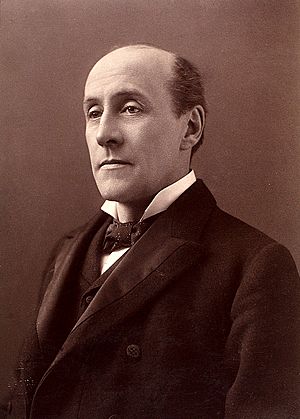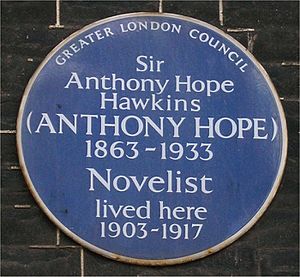Anthony Hope facts for kids
Quick facts for kids
Anthony Hawkins
|
|
|---|---|
 |
|
| Born | 9 February 1863 Clapton, London, England
|
| Died | 8 July 1933 (aged 70) Walton-on-the-Hill, Surrey, England
|
| Other names | Anthony Hope |
| Occupation | Barrister Writer |
|
Notable work
|
The Prisoner of Zenda Rupert of Hentzau |
Sir Anthony Hope Hawkins, better known as Anthony Hope (born February 9, 1863 – died July 8, 1933), was a British writer. He wrote many adventure novels and plays. He is most famous for two books: The Prisoner of Zenda (1894) and its follow-up, Rupert of Hentzau (1898).
These books are considered important in English literature. They take place in a made-up country called Ruritania. These stories helped create a new type of book called "Ruritanian romance." These are adventure stories set in fictional European places. Zenda has been made into movies and plays many times. The 1937 and 1952 Hollywood movies are very well-known.
Contents
Early Life and Becoming a Writer

Anthony Hope went to school at St John's School, Leatherhead and Marlborough College. He then studied at Balliol College, Oxford University. He was a very good student there.
After university, Hope trained to be a barrister, which is a type of lawyer. He started working as a lawyer in 1887. His boss, H. H. Asquith, who later became Prime Minister, thought Hope would be a great lawyer. But Hope decided to become a writer instead.
In his early years, Hope had extra time because his law work was not always busy. He lived with his father, who was a vicar. Hope started writing short stories for magazines. His first book, A Man of Mark (1890), was published by himself. This book was set in a made-up country, like Zenda.
More novels and short stories followed, like Father Stafford in 1891. In 1892, he tried to become a Member of Parliament for the Liberal Party but he did not win.
In 1893, he wrote several novels and sketches. These sketches were put together in a book called The Dolly Dialogues (1894). This book was his first big success. People praised it for its clever humor and how well it showed London life in the Victorian era.
The Prisoner of Zenda
The idea for The Prisoner of Zenda came to Hope in late 1893 while he was walking in London. He wrote the first version of the book in just one month. It was published in April 1894.
The story is set in the fictional European kingdom of 'Ruritania'. This name is now used for any made-up country in a romantic adventure story. Zenda became popular right away. Its main character, Rudolf Rassendyll, became very famous. Other writers and critics, like Robert Louis Stevenson, loved the novel.
Because Zenda was so popular, Anthony Hope decided to stop being a lawyer and become a full-time writer. However, many people felt that he never wrote another book quite as good as The Prisoner of Zenda.
Later Books and Achievements
Anthony Hope wrote 32 books during his life. He had many fans. In 1896, he published The Chronicles of Count Antonio. In 1897, he wrote Phroso, an adventure story set on a Greek island. He also traveled to the United States for a book tour. Reporters described him as a well-dressed Englishman with a good sense of humor.
In 1898, he wrote Simon Dale, a historical novel. He also wrote a play called The Adventure of Lady Ursula. Other books followed, like The King's Mirror (1899), which he thought was one of his best. He also wrote Quisanté (1900) and Tristram of Blent (1901).
In 1906, he published Sophy of Kravonia, another novel similar to Zenda. This story was made into two movies. He continued to write short stories and novels, including Tales of Two People (1907) and Second String (1910).
During World War I, Hope wrote many plays and non-fiction works about politics. Some of these were for the British government's Ministry of Information. Later books included The Secret of the Tower (1919) and Lucinda (1920).
Personal Life and Death
Anthony Hope married Elizabeth Somerville in 1903. They had two sons and one daughter. In 1918, he was made a knight by the King. This was for his work helping with information efforts during World War I.
He wrote a book about his own life called Memories and Notes in 1927.
Anthony Hope died from throat cancer at age 70. He passed away at his home in Walton-on-the-Hill, Surrey. There is a special blue plaque on his house in Bedford Square, London, to remember him.
See also
 In Spanish: Anthony Hope para niños
In Spanish: Anthony Hope para niños


